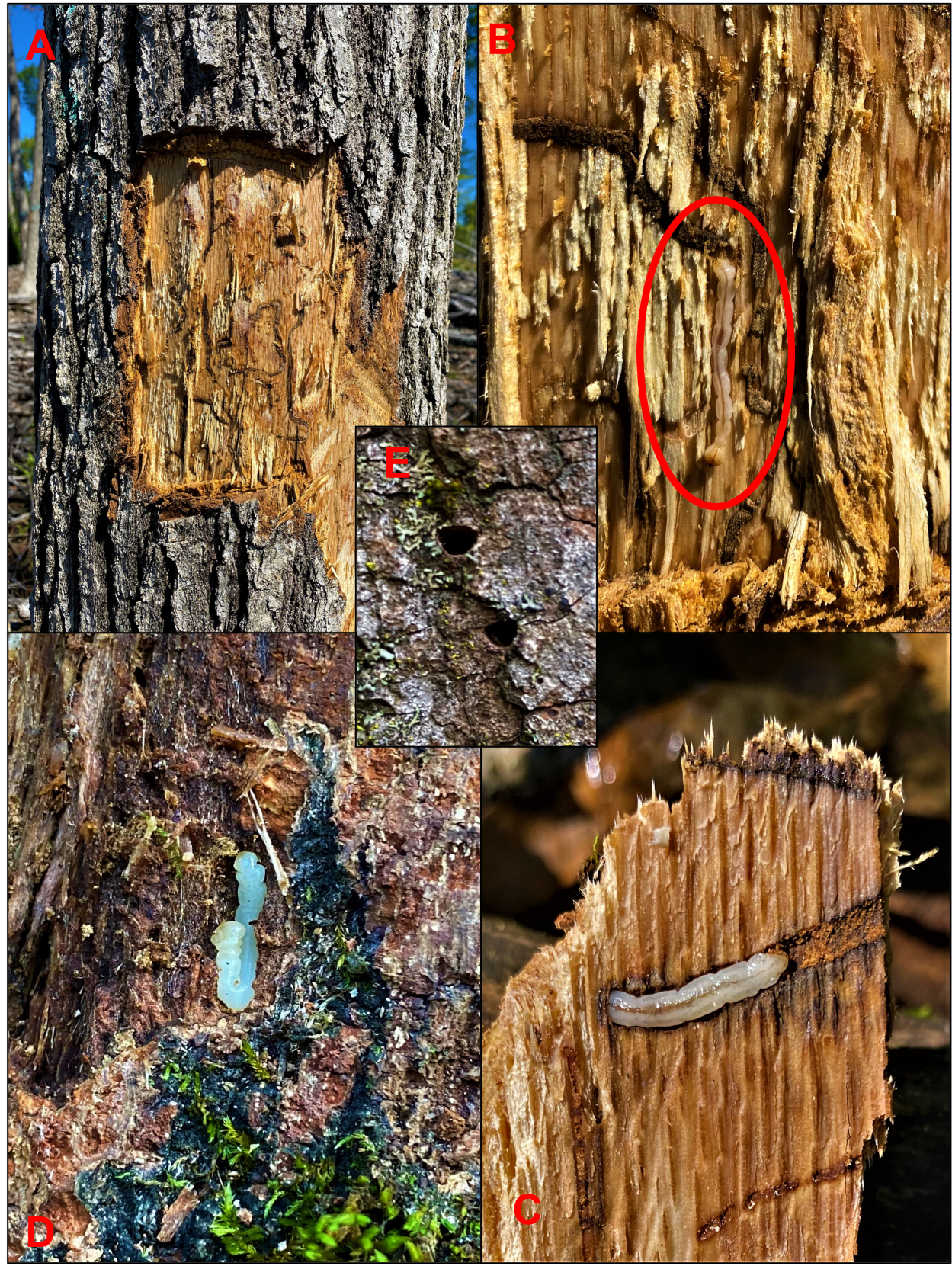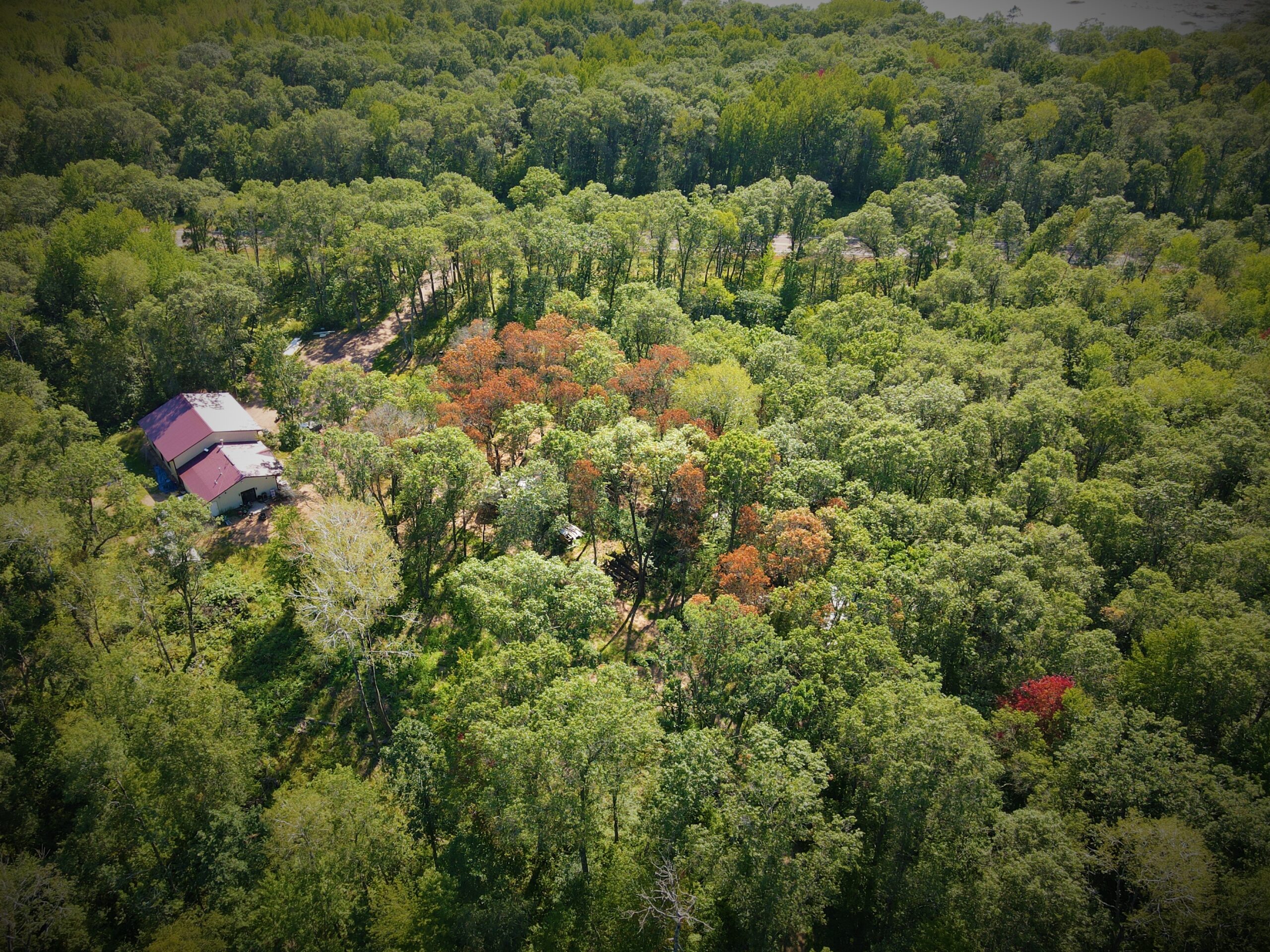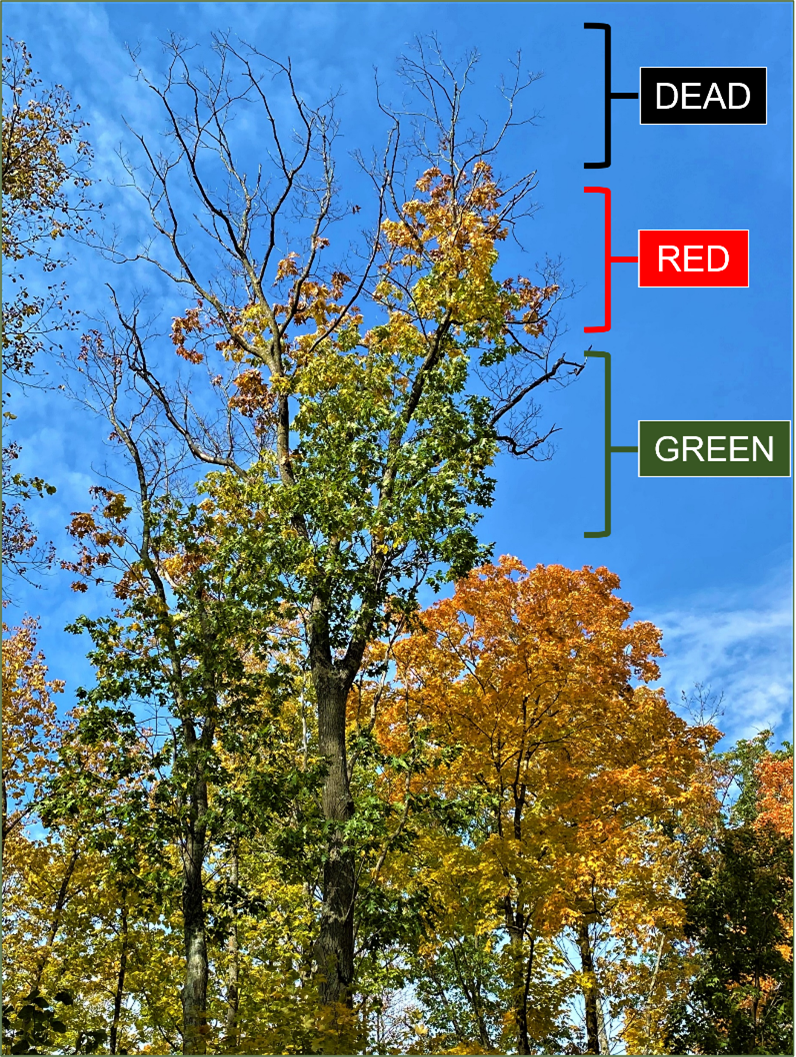By Paul Cigan, DNR Forest Health Specialist, Hayward, Paul.Cigan@wisconsin.gov or 715-416-4920
Twolined chestnut borer (TLCB) attacks on oak trees have increased in numerous Wisconsin counties, with decline and associated mortality in the last two growing seasons, most noticeably since August.
Symptoms of infestation by this native beetle are initially seen in mid-July on the outer portions of branches in the upper crown. Leaves begin to fade from green to yellow to red. Within a matter of weeks, they turn brown and remain on the branches for weeks to months. Their foliage may also appear sparse or completely bare (Fig. 1).

Figure 1. Northern red oaks with symptoms of twolined chestnut borer, ranging from crown thinning and leaf chlorosis like the tree on the left (early stage) to dead top branches like the tree on the right (intermediate stage). Photo: Wisconsin DNR
TLCB will attack stressed oaks for several consecutive years, which can lead to tree mortality. The larvae tunnel through the water and nutrient-conducting tissues (Fig. 2) at progressively lower heights of the tree crown and stem each year.

Figure 2. A: Twolined chestnut borer (TLCB) galleries. B: TLCB larva feeding on phloem tissue. C: TLCB larva excavating a pupal chamber in the outer bark. D: TLCB pre-pupa preparing to overwinter in a pupal chamber, where in the spring, it will molt into an adult beetle and emerge in June. E: TLCB adult beetle exit holes. Photo: Wisconsin DNR
Although less common, oaks under significant stress can be attacked and killed within a single growing season (Fig. 3).

Figure 3. Oaks with significant stress from drought and soil disturbance can be killed in a single growing season, with full crowns of dead leaves that stay on the tree for months. Photo: David Schroeder
However, some oaks may mount a successful defensive response, overcoming invading TLCB larvae and recovering from a year or two of light infestation, provided the initial stress-causing factors resolve and tree vigor improves.

Figure 4. Oak tree with a signature crown dieback pattern, conveniently remembered as “green (leaves), red (leaves), dead (no leaves)” when viewing the vertical pattern of decline from the lower to the middle to the upper portions of the crown, respectively. Photo: Wisconsin DNR
The progressive decline from repeated attacks over multiple years can leave a tree crown with a staghorn appearance (Fig. 1, tree on the right), as well as a signature crown dieback pattern, conveniently remembered as “green (leaves), red (leaves), dead (no leaves)” when viewing the vertical pattern of decline from the base to the middle to the upper portions of the crown, respectively (Fig. 4).
TLCB signs can include winding, angular feeding tunnels called galleries on the sapwood surface (occasionally accompanied by actively feeding or overwintering larvae) and D-shaped exit holes (Fig. 2).
TLBC symptoms can easily be confused with oak wilt, and trees can be afflicted with both simultaneously. The most consistent differences between the two are the retention of dead leaves (TLCB), as well as crown dieback with the presence of some green and otherwise healthy leaves lower in the crown (TLCB). Lab testing is the most reliable diagnostic tool and should be considered in cases where the symptoms of oak wilt and TLCB are too difficult to distinguish.
The trend of increased TLCB activity has heightened in 2022, with oak mortality commonly observed in landscape trees, forest edges and, recently, thinned oak stands. Mortality has also been present, but infrequent in undisturbed stands with no recent harvesting activity. Infestations have been most common on forest edges where recent ground disturbance or soil compaction has placed additional strain on drought-stressed oaks (Fig. 3). A dry regional weather pattern, beginning in mid-2021, has persisted through the current growing season in many areas, ranging from abnormally dry to severe drought conditions, thereby increasing oak stress and susceptibility to TLCB attack.
With the drought conditions and higher TLCB numbers, coupled with defoliation caused by oak leaf roller and spongy moth (formerly known as gypsy moth), be cautious when managing oak stands and caring for landscape oaks.
Recommendations in managed stands:
- Postpone harvest operations in oak-dominated stands for 3-4 years after drought and/or heavy defoliation. Consider the impacts of any recent and/or predicted stress-causing events (such as spongy moth defoliation) and be flexible with scheduling management activities.
- Salvage infested oak stands only during frozen ground conditions to avoid causing additional stress within a stand.
- Promote vigorous oak stands by maintaining normal stocking levels and harvesting overly stocked stands when other stress-causing factors have subsided.
- Oaks with 50% or greater crown dieback are considered high risk when marking trees for removal.
Recommendations for oaks in landscapes and woodlots:
- Avoid any injury to oaks from April through July.
- Avoid soil and ground disturbance within the dripline (equivalent to the outer perimeter of the tree crown), including digging, equipment and vehicle travel, installing landscaping tiles or stone and changing grade with fill or gravel.
- Avoid harvesting in oak woodlots for 3-4 years after drought and/or heavy defoliation, and avoid harvesting up to oaks on an edge, leaving them in full to partially full sunlight.
- Maintain adequate soil moisture by watering oaks with a soaker or drip hose for 1 hour per week during dry periods through the growing season.
- For high-value oaks, systemic insecticides (such as drenches and injectables) labeled for TLCB can protect and help oaks with limited dieback recover.
- Harvesting and splitting actively infested oaks by the end of August and putting them in a dry, sunny location may dry out resident borers before they mature. Debarking, burning and chipping wood may also disrupt the TLCB life cycle.
For more information, contact your local DNR forest health specialist.
